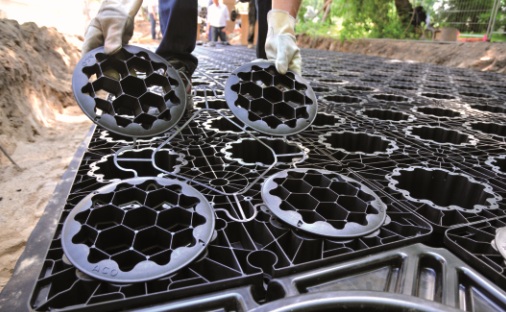
ACO Stormbrixx - a new product in the field of retention and infiltration II.
Retention of rainwater – regulated outflow
The regulated outflow of rainwater into the sewer system or watercourse is becoming increasingly important, especially during heavy rainfall. The highest flow rates of rainwater during heavy downpours are thus dampened and spread out over a longer period. ACO Stormbrixx can first collect and retain rainwater as a retention tank, and then controllably and gradually release it into the watercourse or sewer system.
Dampening rainfall
Dampening rainfall is understood as a process in which the highest flow rate of a sudden downpour is distributed over a longer time period, allowing the water to be drained slowly and reducing the peak outflow quantity of water.
The regulated outflow of rainwater into the sewer system or watercourse is becoming increasingly important, especially during heavy rainfall. The highest flow rates of rainwater during heavy downpours are thus dampened and spread out over a longer period. ACO Stormbrixx can first collect and retain rainwater as a retention tank, and then controllably and gradually release it into the watercourse or sewer system.
.jpg) |
Dampening rainfall is understood as a process in which the highest flow rate of a sudden downpour is distributed over a longer time period, allowing the water to be drained slowly and reducing the peak outflow quantity of water.
Infiltration of rainwater – effective creation of new groundwater
The creation of new groundwater is one of the central themes in rainwater management. Thanks to the development of the infiltration system ACO Stormbrixx, ACO offers a concept that represents an ecologically valuable and effective solution for draining newly constructed projects in civil engineering, transport infrastructure, or residential construction, as well as in cases of subsequent disruption of impermeable public or private surfaces followed by infiltration. During infiltration, the emerging rainwater is first collected in the ACO Stormbrixx drainage system and then gradually infiltrates into the surrounding soil.
.jpg) |
The following images show the installation process of ACO Stormbrixx
 |
The basic footprint dimensions of the excavation must ensure a working space of 300 mm on all sides, allowing workers on the construction site to position the ACO Stormbrixx blocks, geotextile, and geomembrane into the appropriate position. Ideally, the footprint area should be marked with spray paint or marking string.
The bearing capacity of the soil at the bottom of the excavation must correspond to the designed loads. All soft clay is removed from the excavation and replaced with compacted non-cohesive material.
The bearing capacity of the soil at the bottom of the excavation must correspond to the designed loads. All soft clay is removed from the excavation and replaced with compacted non-cohesive material.
 |
At the bottom of the excavation, a 100 mm compacted base layer is leveled. Proper leveling and smoothing of the base layer is crucial, and the bearing capacity of the subgrade must correspond to the proposed loads.
Geotextile is laid on the base layer and along the sides of the excavation, ensuring that the minimum overlapping distance of the individual strips is 300 mm.
The assembly of the modular units ACO Stormbrixx is done according to the footprint size and the required configuration of the units. Geotextile is laid on the base layer and along the sides of the excavation, ensuring that the minimum overlapping distance of the individual strips is 300 mm.
|
|
||
|
|
 |
 |
Use side panels on all external boxes around the tank structure to create a solid side wall.
 |
Covers prevent soil from falling into the openings.
 |
Continue with the hermetic sealing of the geomembrane using weld joints or tapes.
 |
The excavation is evenly filled with base material or chosen non-cohesive material in layers of 150-300 mm and subsequently compacted.
Areas with traffic (e.g., parking lots with restricted access for certain vehicles): Base material compacted to 150 mm. The load on the top of the system due to the compaction device must not exceed 2300 kg per 1 m width. If the units are to be installed under a paved area, the backfill may include reinforcement base material, provided that the minimum depth of the cover layer is maintained.
Areas with garden or landscaping and areas without traffic: chosen excavated material with particles smaller than 40 mm in a 300 mm layer above the units. Above this level, chosen excavated material may be used. Backfilling and compaction in layers max. 300 mm. The load on the top of the system due to the compaction device must not exceed 2300 kg per 1 m width.
Areas with traffic (e.g., parking lots with restricted access for certain vehicles): Base material compacted to 150 mm. The load on the top of the system due to the compaction device must not exceed 2300 kg per 1 m width. If the units are to be installed under a paved area, the backfill may include reinforcement base material, provided that the minimum depth of the cover layer is maintained.
Areas with garden or landscaping and areas without traffic: chosen excavated material with particles smaller than 40 mm in a 300 mm layer above the units. Above this level, chosen excavated material may be used. Backfilling and compaction in layers max. 300 mm. The load on the top of the system due to the compaction device must not exceed 2300 kg per 1 m width.
The English translation is powered by AI tool. Switch to Czech to view the original text source.
0 comments
add comment















